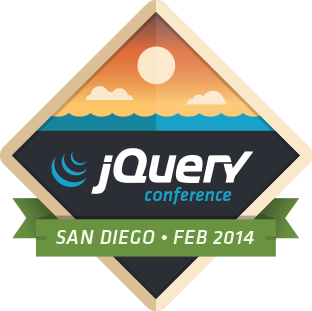As I sit here in New York City in the wake of a nor’easter that just hammered the, uh, Northeast, it’s hard not for me to be excited for the next jQuery Conference, which is just three short weeks away in sunny San Diego, California. So excited, in fact, that I wanted to take a couple minutes to bring you up to speed on what we’ve got in store for you the week of February 10th!
That’s What I’m Talking About
If you missed our announcements over at @jqcon over the past few weeks, we’ve rolled out a great lineup of speakers, who will be presenting on an array of subjects covering jQuery and beyond. We’ll be hosting our first-ever guest keynotes, as we proudly welcome chat.meatspac.es creatorbro herself, Edna Piranha, who’ll share both the history and the future of the web’s first ephemeral, WebRTC-powered, animated-GIF-generating chat service, and Scott Hanselman, who’ll discuss JavaScript’s impact on application architecture and its growing appeal as a compilation target. As usual, project leads Dave Methvin and Scott González will start off each day with keynotes updating you on what’s new in jQuery, jQuery UI and jQuery Mobile development.
We’re back to our familiar two-track lineup, and this time we’ve curated them in order to help you get a well-rounded look at JavaScript and front-end development tools and techniques that you can go back home and use. As always, you’re of course free to pick and choose between talks in both tracks.
First up is our Fundamentals track. With talks ranging from debugging and scope to the basics of testing (and automating that testing), the Fundamentals track is meant to help introduce and reinforce common and emerging concepts and practices that are integral to building successful web apps today. It’s far from a refresher course, however, and also includes subjects like how to secure client side apps, responsive design, and how to organize jQuery and JavaScript applications to keep them lean and mean.
Next door, we’ll have our Code For Thought track, a wide-ranging exploration of a breadth of topics related to the ever-changing world of web application development with JavaScript. We’ll talk about how jQuery 2.0 and its modular build system make jQuery an even more viable candidate for even low-bandwidth situations, and how you can apply performance improvements in jQuery Mobile 1.4 to your own applications. We’ll spend plenty of time looking at newer technologies, including Firefox OS, new HTML5 speech APIs, and Node.js. And we’ll dive deep, discussing advanced subjects like implementing code coverage analysis, building your own tools, writing third-party JavaScript apps, and why jQuery is still an incredibly useful tool even as the browser landscape has improved over the last few years.
With over 30 talks, this is only a sampling of the speakers and subjects on offer. We’re sure jQuery San Diego will have more than a little bit of something for everyone; head on over to review the whole program to see the full abstracts for all of our sessions.
The Roost Boost
This year, we’re partnering with Bocoup to extend the festivities, bringing you a pre-conference training event in the form of Roost, a two-day intensive course on crafting modern web applications taught by Ben Alman, Irene Ros, Mike Pennisi, and Bob Holt. Roost is targeted at developers who already know JavaScript, jQuery, HTML, and CSS, and are looking to understand how to develop a better workflow for building, testing, and maintaining their applications and incorporate technologies like Backbone, RequireJS, Stylus, and more. You can check out the full training curriculum and schedule to find out exactly what’s planned.
We Like, We Like To Party
We’re happy to announce that we’re hosting a conference party at Fiesta de Reyes after the first day of talks, February 12. Located just a trolley ride away from the conference in the heart of San Diego’s Old Town, it’s a great spot and we’re looking forward to having a few hours to relax with the community – food and drinks are on us!
Brought To You By
We’d be remiss if we didn’t give a shout out to the sponsors who are stepping up to help us put together a great jQuery Conference: Diamond sponsor WordPress, Platinum sponsor MaxCDN, Gold sponsors Bocoup & BrowserStack, and Silver sponsors WalmartLabs & New Relic. Thanks! (We’re still welcoming sponsors – if you’d like to have your company be a part of #jqcon, please get in touch!)
Student Discount
We’re glad to be able to offer a discount to current students. Anyone from kindergarten right on up through graduate school may use coupon code jqstudentSD14 to save $100 off a ticket to jQuery San Diego or a combo ticket to jQCon and Roost. Though we know the discount is modest, this is the first time we’ve been able to offer a student discount of any kind, so we hope it helps. Please be advised that if you use this discount, you’ll need to show a valid student ID at registration.
I Read This Whole Blog Post, What’s In It For Me?
Fifty bucks! No joke – register now for jQuery Conference, Roost, or both using discount code jqblog50 to save an $50 on your ticket!
We’ve been working hard to make our trip to the west coast the best #jqcon yet, and hope you’ll be able to be part of the whole week. Check out the conference site for more on our program and speakers, lodging, and to buy your tickets. If you have any questions, always feel free to get in touch with us on Twitter or via e-mail.


